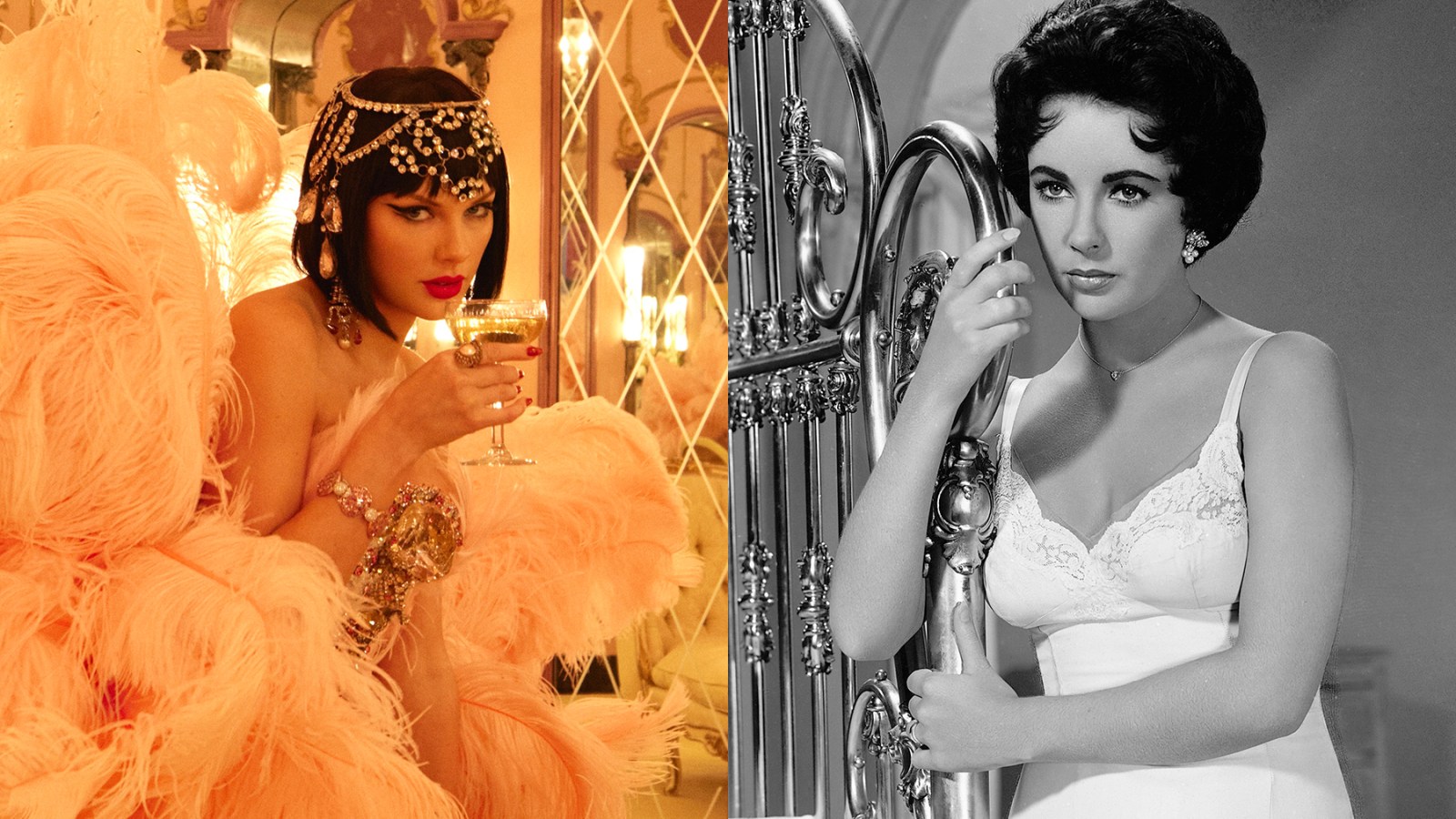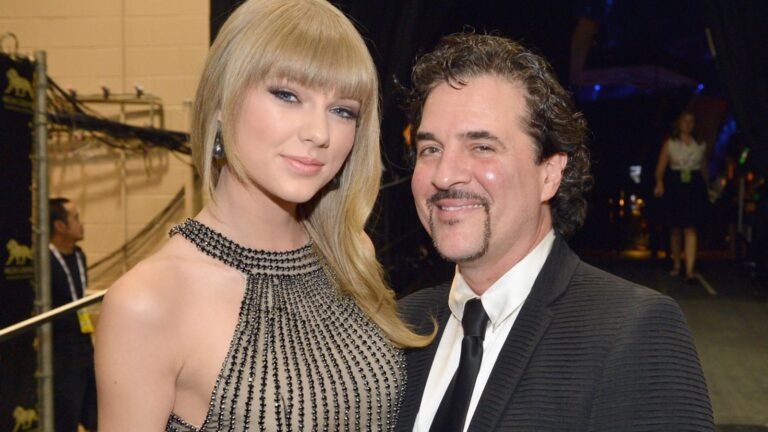Taylor Swift loves her mad women and outlaw ladies, her queens with big reputations. She also loves her Old Hollywood movie stars, from Clara Bow to Barbara Stanwyck to Bette Davis. So it would be bizarre if she didn’t have an Elizabeth Taylor obsession. La Liz was an opulent mess her whole life. She was the most famous woman of the 20th century, as Taylor is now — the ultimate showgirl. Everything she did was on an epic scale — her movies, her clothes, her diamonds, her violet eyes, her marriages, her scandals.
But “Elizabeth Taylor” is so much more than just the peak of her long-running Liz fascination. It’s a statement of purpose, the heart-on-fire synth-pop swoon at the core of her dazzling new album The Life of a Showgirl. She and Max Martin and Shellback go 12 for 12 — they basically made a 41-minute New Romantics: The Album. But “Elizabeth Taylor” feels like the emotional centerpiece, the key to the whole record. The showgirl yearns for true love — yet on her own fiercely independent terms. Swift has always identified with Liz, but this is where she claims the story as her own. She’s immortal now, baby dolls.
Obviously, there’s no winning streak like Taylor’s anywhere in music history — nearly 20 years in, she keeps hitting new peaks in her cultural impact and creative ferocity. (And oh yeah, commercial success.) Song for song, Showgirl is her best since the Folklore/Evermore double-shot of five years ago — that might look like an unbeatable zenith, but then so did Red before Folklore happened. So many contenders for the album’s funniest line, yet “Elizabeth Taylor” has the winner: “We hit the best booth at Musso and Frank’s / They call me bad news, I just say thanks.” (A close second: “I have been afflicted by a terminal uniqueness.”)
The song digs into one of her favorite Hollywood legends: Liz’s stormy romance with the Welsh actor Richard Burton, when they reigned as the world’s most scandalous couple. I’m a hardcore Liz fanatic so I had high hopes for this song, yet Taylor exceeded them. (Sadly, “Wood” did not turn out to be about Natalie.) Liz spent her whole existence in the spotlight, with “lights, camera, bitch smile” as the only life she knew. She tied the knot eight times, including Burton, whom she wed and divorced twice. The whole world knew them as “Liz and Dick.” They were decades too early for a nickname like “Elizadick” or “Turton,” though they called themselves “Le Scandale.” The couple made eleven movies together, and battled through each one.
But the Liz/Swift soul connection goes deep, way beyond their shared name. Both Taylors got famous as kids, grew up in public as America’s sweetheart. As in the title of Liz’s finest early movie, namechecked in the song, both were “The Girl Who Had Everything.” But like Swift, Liz was the ingenue who made everything sticky by growing up. They turned into controversial women, denounced and slut-shamed as their lives became gossip fodder. “The rumors are terrible and cruel, but honey, most of them are true” — that’s a line that could have come from Liz’s lips in Butterfield 8.
Liz and Dick fell in love on the set of Cleopatra, the ridiculously expensive and lavish epic love story of the ancient Egyptian queen and the Roman general Mark Antony. Both stars were married to other people, but who cared? They got hitched in 1963, divorced in 1974, married again in 1975, divorced again in 1976. When they went public, it was an international scandal. Republicans in Congress called for the Attorney General to revoke her passport and cancel his visa. The Vatican newspaper accused them of “erotic vagrancy,” which would make a great Swift song title (and someday probably will).
Swift’s always had a fascination with this power couple. In “…Ready for It?” she sang, “He can be my jailor, Burton to my Taylor,” then added, “I’m so very tame now, never be the same now.” If the word “tame” seems odd there, one of the first movies the pair made together was The Taming of the Shrew, by Tay’s main man William Shakespeare. On her 2018 Reputation Tour, her backstage Rep Room was decorated with a Liz-and-Dick theme, with vintage posters for their movies like Cleopatra and The V.I.Ps.
She also went Liz for her 2014 “Wildest Dreams” video, where she plays a brunette actress filming on location in Africa, falling in love with her co-star. As director Joseph Kahn said, “The video is based on classic Hollywood romances like Elizabeth Taylor and Richard Burton.” The video was set in 1950 — the year of Liz’s first wedding. Her leading man: Scott Eastwood, whose dad co-starred with Burton in Where Eagles Dare. Never accuse Taylor of not obsessing over the details.
She once posted a photo of her cat sitting on a copy of the book Furious Love: Elizabeth Taylor, Richard Burton, and the Marriage of the Century, by Sam Kushner and Nancy Schoenberger. Her caption: “Olivia loves to read historical Hollywood biographies.” In 2018, she discussed this bio in her interview with the rock & roll muse Pattie Boyd (who married both George Harrison and Eric Clapton). “I read a book about Richard Burton and Elizabeth Taylor recently, and how there was this crazy frenzy surrounding them,” Taylor said. “In the book, Elizabeth is quoted as saying, ‘It could be worse—we could be the Beatles.’”
But she goes all the way in “Elizabeth Taylor,” turning her life into folklore. In the opening moments, she sings, “That view of Portofino was on my mind/When you called me at the Plaza Athénée.” That’s the island where Liz and Dick got engaged — and the New York hotel where she had a duplex penthouse. Some of the song’s references are obvious, as in the chorus where she sings, “I’d cry my eyes violet.” But she also goes for deep cuts, shouting out White Diamonds, the name of Liz’s Nineties fragrance, and her finest early movie, the pretty damn obscure 1953 melodrama The Girl Who Had Everything. (Did I mention Taylor obsesses over the details?)
“Often times it doesn’t feel so glamorous being me,” she laments. She might be the talk of Hollywood, but that’s a place where you’re only as hot as your last hit, baby, and she knows people are rooting for her to take a fall. “All my white diamonds and lovers are forever,” she sings—but in the title song, at the the album’s end, it’s “sequins are forever.”
Elizabeth was a child when she became a sensation riding her horse in National Velvet. In her teens, she stared at the older actresses eating lunch in the studio commissary, the glam divas like Ava Gardner and Lana Turner, and wanted to be just like them. She used to have herself paged, just so she could walk across the lunch room and try to turn heads. It usually worked. Even at 19, she was seen as a femme fatale. “I know I have been spoiled,” she said. “But I think people have been unfairly severe.” She never got a chance to mature in private. “I’ve been able to wear a plunging neckline since I was 14 years old,” she said. “My troubles all started because I have a woman’s body and a child’s emotions.”
Liz always had the most bitter exes in the game. Her first husband, whom she married at 18 and left at 19, told the press, “Every man should have the opportunity of sleeping with Elizabeth Taylor, and at the rate she’s going every man will.” But the most bitter had to be crooner Eddie Fisher, her fourth husband, who suffered the public humiliation of leaving his wife Debbie Reynolds for her (as well as their daughter Carrie), then getting dumped for Burton. He did a revenge-theater show with a song called “Cleo, the Nympho of the Nile,” with lyrics such as “Just like Elvis/She used her pelvis.” (This story, like so many great Liz tales, comes from Kitty Kelley’s classic Elizabeth Taylor: The Last Star, one of the juiciest Hollywood dishfests ever.)
Before Cleopatra, Liz and Dick despised each other. When they first met, he was starring in a London production of Hamlet, and naturally having an affair with the actress playing Ophelia, Claire Bloom. (Just as Taylor plays Ophelia on the album cover.) But he and Liz fell in hate at first sight. He called her “MGM’s Little Miss Mammary.” She called him “the Frank Sinatra of Shakespeare.” When he got cast as Mark Antony, he complained, “Well, I guess I’ve got to don my breastplate once more to play opposite Miss Tits.” But a week into filming, they were inseparable, sneaking off to his trailer between scenes.
Burton wasn’t her most likeable husband (that would be Michael Wilding) or her most attractive (Mike Todd), or even the hammiest actor (Fisher), but they were addicted to each other. Both were jet-set alcoholics; by the end, he drank three bottles of vodka a day. When he died in 1984, his widow banned Liz from the funeral. Everyone had opinions about these two. Even Bob Dylan, on his 1963 classic The Freewheelin’ Bob Dylan — the folk poet spends the album pondering big themes like war, justice, and death, but his final punch line is “Make love to Elizabeth Taylor / Catch hell from Richard Burton.”
Cleopatra was Liz’s favorite role — she identified with the passionate queen. “To me,” she said, “Cleopatra was more like a tigress than a sex kitten, even at 19, when she first met Caesar and had been queen for only two years.” Taylor can relate to that — in the Speak Now vault track “When Emma Falls in Love,” she sings about a girl who’s “like if Cleopatra grew up in a small town.” (And like Taylor, Cleo had some issues with snakes.) Liz won her first Oscar for Best Actress as the vamp in Butterfield 8, purring lines like “Flesh and blood can only stand so much voluptuous torture.” But in their movies together, she and Burton loved to play couples at war with each other, throwing their real-life conflicts into Who’s Afraid of Virginia Woolf? That film might be a Tay fave, considering “Who’s Afraid of Little Old Me,” where she sings about growing up in the fame machine as Liz did, sneering, “You wouldn’t last an hour in the asylum where they raised me.”
But Elizabeth Taylor specialized in a very Swiftian kind of role: the woman who lives with a horrible secret she can never tell, because nobody would believe her. If she trusted anyone enough to confide in them, they’d call her insane. (“This you won’t believe!” she screams in Suddenly Last Summer. “Nobody, nobody could believe it!” When she tells her secret, she gets locked in an asylum.) Liz played this woman so many times — and so has Taylor, in songs from “Cassandra” to “Mad Woman” to the new album’s “Cancelled!” But she has so many of these characters in plain sight — like in “Blank Space,” where she’s got a long list of ex-lovers who’ll tell you she’s insaaaane. As she once asked, “When everyone believes you, what’s that like?”
When Liz died in 2011, at 79, it was the end of an era. “The last of the Hollywood greats,” in the words of George Michael — another legend who gets a Showgirl showcase, in “Father Figure.” (It’s George’s song title, but it also sounds like his career story.) She married a “Father Figure” once—the distinguished British actor Michael Wilding, twice her age. She turned 20 on their honeymoon. By all accounts, this was one of her friendliest marriages, producing two sons and no hard feelings. Their son Christopher, now 70, has thanked Swift for writing a song about his mom. Her third husband was a Broadway producer killed in a plane crash; her seventh was the Senator from Virginia; her eighth was a construction worker she met in rehab. This woman took big swings.
But Liz was protective of her image, long past the point where it was out of her hands. She sued to stop a biopic in 1982, saying, “I am my own commodity. I am my own industry.” These words were much-mocked, like everything she said or did in those days. (The movie finally happened in the Nineties, starring Twin Peaks siren Sherilyn Fenn. A few years ago, it was Lindsay Lohan.) Yet Taylor Swift is one of the few people who knows exactly what Liz was talking about. She said something similar during the New Heights podcast with Travis Kelce, discussing her fight to own her masters. “I’m in the business of human emotion,” she said. “So I would so much rather lead heart-first in something like this, because to me this isn’t something like, ‘I want to own this asset because of its return.’ I want it because these are my handwritten diary entries from my whole life.”
That’s the real bond between these two Taylors — their lifelong fight to hold on to their independence, despite public exposure. “It’s the life behind it all,” Swift said on New Heights. “It’s the life beyond the show.” At the very end of the album, she brings the story full circle with the title tune, dedicated to a tough dancer named Kitty. (Liz was a lifelong cat lady, not to mention Maggie the Cat in the 1959 classic Cat on a Hot Tin Roof.) But this could be Elizabeth’s story as well as Swift’s. “I’m married to the hustle,” Taylor proclaims. “Now I know the life of a showgirl, babe, and I’ll never know another. Pain, hidden by the lipstick and lace.” Both Taylors know this life from the inside. Nobody except the showgirls will ever understand.



